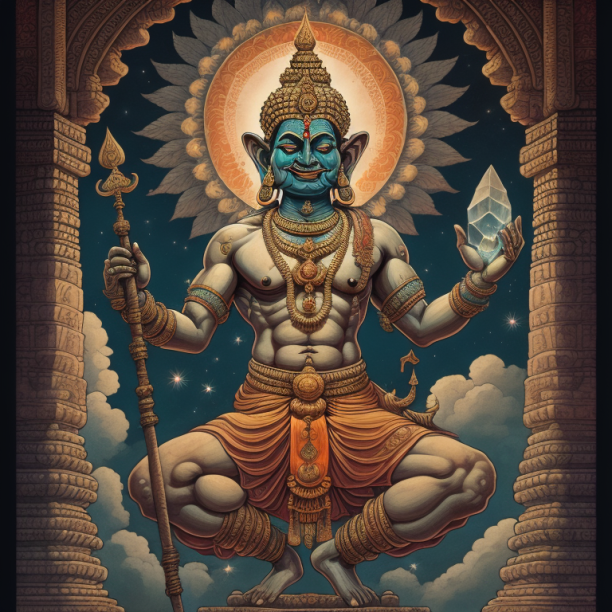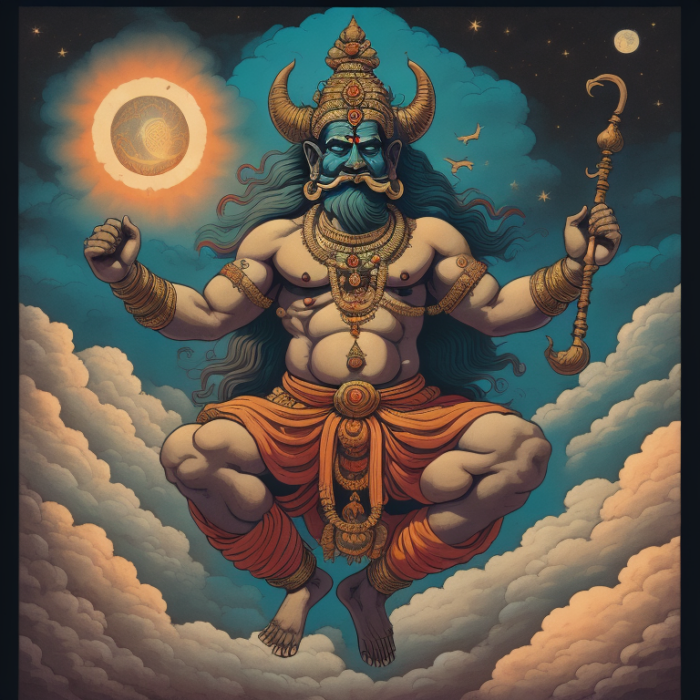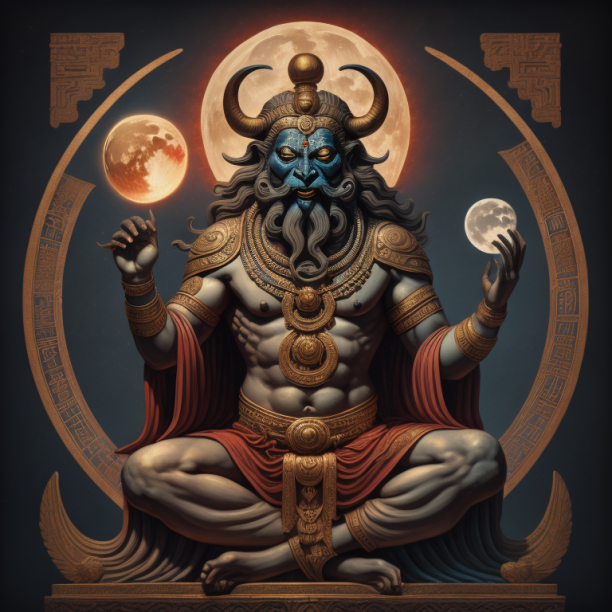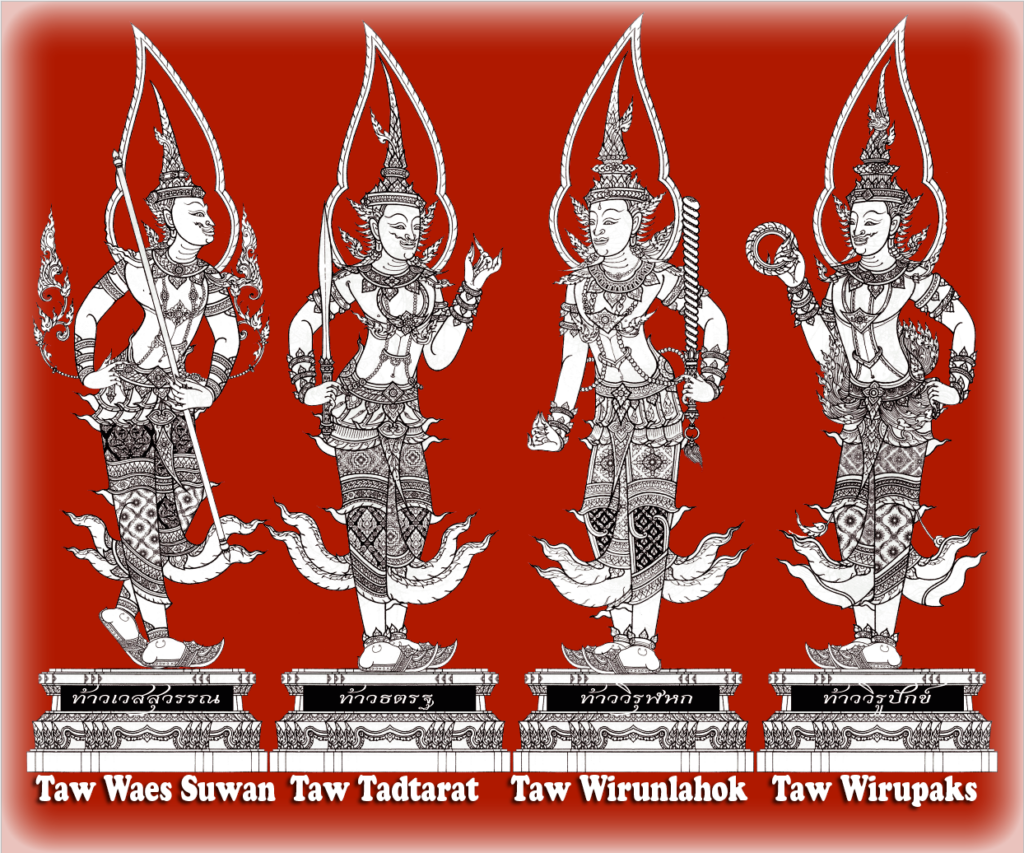The Four Heavenly Kings, known as the “Caturmahārāja” in Sanskrit, and “Sì Dàtiānwáng” in Chinese, are four prominent figures in Buddhist mythology. They are believed to be gods or devas who watch over the cardinal directions of the world. In Thai Buddhist beliefs, as well as in Chinese and other Buddhist cultures, these celestial beings play significant roles.

In Thai culture, the Four Heavenly Kings are known as “Chatumaharacha” or “Chatulokkaban.” Each king has a specific direction and associated qualities. Vessavana, also known as Vaiśravaṇa or Kubera, is the chief of the kings and protector of the north. He is associated with the color yellow or green and symbolizes abundance and wealth. Virūlhaka, the king of the south, is known for causing good growth and is associated with the color blue. Dhatarattha, the king of the east, represents harmony and compassion, often depicted with a pipa, a stringed instrument. He is associated with the color white. Virūpakkha, the king of the west, has the ability to see all and convert non-believers. He is associated with the color red and often depicted with a serpent or red cord.

The Four Heavenly Kings are said to reside in the Cāturmahārājika heaven, situated on the lower slopes of Mount Sumeru. They are regarded as protectors of the world and defenders of the Dharma. Each king has the ability to command a legion of supernatural creatures to safeguard Buddhism.
Now, let’s explore the realm of the Asura and Yaksha in Buddhist mythology. Asuras are considered to be powerful beings who dwell in a realm known as the Asura realm. They are often depicted as fierce and war-like. In Thai Buddhist beliefs, there are several famous Asura Devas.
Pra Rahu, also known as the Eclipse Deity, is a significant figure in Thai Buddhism. He is believed to be an Asura Deva who swallows the sun or moon during eclipses. Devotees offer prayers and offerings to appease Pra Rahu and seek his blessings.
Taw Waes Suwan is another well-known Asura Deva in Thai Buddhist beliefs. He is associated with wealth, protection, and victory. Devotees believe that worshiping Taw Waes Suwan brings prosperity and success in various endeavors.

Pipek, also known as Bibheka, holds a prominent role in the Thai adaptation of the Indian epic Ramayana, known as the Ramakien. In the Ramakien, Pipek is portrayed as a mighty Asura warrior who assists the demon king, Thotsakan (Ravana). Pipek is often depicted with a bird-like appearance, wearing golden armor, and wielding various weapons. His character represents loyalty and dedication to his king.
Atanatiya Paritta:

Here is the English Romanized version of the Atanatiya Paritta using Romanized Pāli characters:
Namo tassa bhagavato arahato sammā sambuddhassa. Yo so tathāgato araham sammasambuddho vijjācaraṇa sampanno sugato lokavidū anuttaro purisadammasārathi satthā devamanussānaṃ buddho bhagavāti.
Yo imaṃ lokaṃ sadevakaṃ samārakaṃ sabrahmakaṃ sassamaṇabrāhmaṇiṃ pajaṃ sadeva manussaṃ samārakaṃ sabrahmakaṃ sassamaṇabrāhmaṇiṃ pajāṃ sadeva manussaṃ ākāsānañcāyatanūpagānaṃ devānaṃ sahabyataṃ yathākkāmaṃ yathārahaṃ ākāsānañcāyatanūpagā devānaṃ sahabyataṃ upasaṅkamati.
So imaṃ lokaṃ sadevakaṃ samārakaṃ sabrahmakaṃ sassamaṇabrāhmaṇiṃ pajaṃ sadeva manussaṃ samārakaṃ sabrahmakaṃ sassamaṇabrāhmaṇiṃ pajāṃ sadeva manussaṃ ākāsānañcāyatanūpagānaṃ devānaṃ sahabyataṃ yathākkāmaṃ yathārahaṃ ākāsānañcāyatanūpagā devānaṃ sahabyataṃ anuttaraṃ sammāsambodhiṃ abhisambuddho.
So sadevakaṃ samārakaṃ sabrahmakaṃ sassamaṇabrāhmaṇiṃ pajaṃ sadeva manussaṃ samārakaṃ sabrahmakaṃ sassamaṇabrāhmaṇiṃ pajāṃ sadeva manussaṃ ākāsānañcāyatanūpagānaṃ devānaṃ sahabyataṃ yathākkāmaṃ yathārahaṃ ākāsānañcāyatanūpagā devānaṃ sahabyataṃ anuttaraṃ sammāsambodhiṃ abhisambuddhā.
Yo imaṃ lokaṃ sadevakaṃ samārakaṃ sabrahmakaṃ sassamaṇabrāhmaṇiṃ pajaṃ sadeva manussaṃ samārakaṃ sabrahmakaṃ sassamaṇabrāhmaṇiṃ pajāṃ sadeva manussaṃ ākāsānañcāyatanūpagānaṃ devānaṃ sahabyataṃ yathākkāmaṃ yathārahaṃ ākāsānañcāyatanūpagā devānaṃ sahabyataṃ upasaṅkamati.
Seyyathāpi nāma mahāmegho gambhīre udakarahade vassamāno na yojanaṃ puratthimaṃ yojanaṃ pacchimaṃ yojanaṃ uttaraṃ yojanaṃ dakkhiṇaṃ yojanaṃ puratthimaṃ yojanaṃ pacchimaṃ yojanaṃ uttaraṃ yojanaṃ dakkhiṇaṃ yojanaṃ puratthimaṃ yojanaṃ pacchimaṃ yojanaṃ uttaraṃ yojanaṃ dakkhiṇaṃ yojanaṃ ākāsānañcāyatane pathavīdhātuyā ādittaṃ sampajjalitaṃ vipariṇāmadhammaṃ ākāsānañcāyatane viññāṇadhātuyā ādittaṃ sampajjalitaṃ vipariṇāmadhammaṃ ākāsānañcāyatane saññādhātuyā ādittaṃ sampajjalitaṃ vipariṇāmadhammaṃ ākāsānañcāyatane saṅkhāradhātuyā ādittaṃ sampajjalitaṃ vipariṇāmadhammaṃ.
Evameva kho panāhaṃ, bhikkhave, imaṃ āṭānāṭiyaṃ parittaṃ abhāsiṃ: Namo ratanattayāya. Namo vijjācaranasaṃpannāya. Namo dhajagga pariveṇīranasanāya. Evaṃ me sutaṃ. Atthi, bhikkhave, aññopi parittaṃ bhesajja-parittan’ti.
The Atanatiya Paritta, also known as the “Discourse of Atanatiya,” is a sacred text in the Theravada Buddhist tradition. It is found in the Digha Nikaya, one of the collections of the Pali Canon, the ancient scriptures of Buddhism. The story of the Atanatiya Paritta revolves around the Buddha and a group of powerful non-human beings known as the Yakshas.
According to the narrative, during the time of the Buddha, a fierce battle erupted between two groups of Yakshas, the followers of the Yaksha king Vessavana and the followers of the Yaksha king Suppabuddha. The conflict escalated to the point where it posed a great threat to the peace and well-being of both the human and non-human realms.
The Buddha, foreseeing the dangers that could arise from this conflict, decided to intervene. He traveled to the Tavatimsa heaven, where the Yakshas resided, and delivered the Atanatiya Paritta as a protective chant. This discourse served as a means to pacify the Yakshas and restore harmony among them.
The Atanatiya Paritta consists of verses describing the qualities of the Buddha, his teachings, and the protective qualities of various deities. It also includes a detailed account of the physical characteristics of the Yaksha king Vessavana and his retinue. The discourse praises the virtues of mindfulness, compassion, and wisdom.
After the Buddha delivered the Atanatiya Paritta, the Yakshas were pacified, and the conflict came to an end. The discourse became highly regarded as a powerful protective chant, capable of warding off malevolent forces and ensuring the safety and well-being of those who recite it.
Since then, the Atanatiya Paritta has been recited by Buddhists on various occasions, particularly during ceremonies and rituals to invoke blessings and protection. It serves as a reminder of the Buddha’s compassionate intervention and the power of his teachings in overcoming adversity and fostering harmony.

